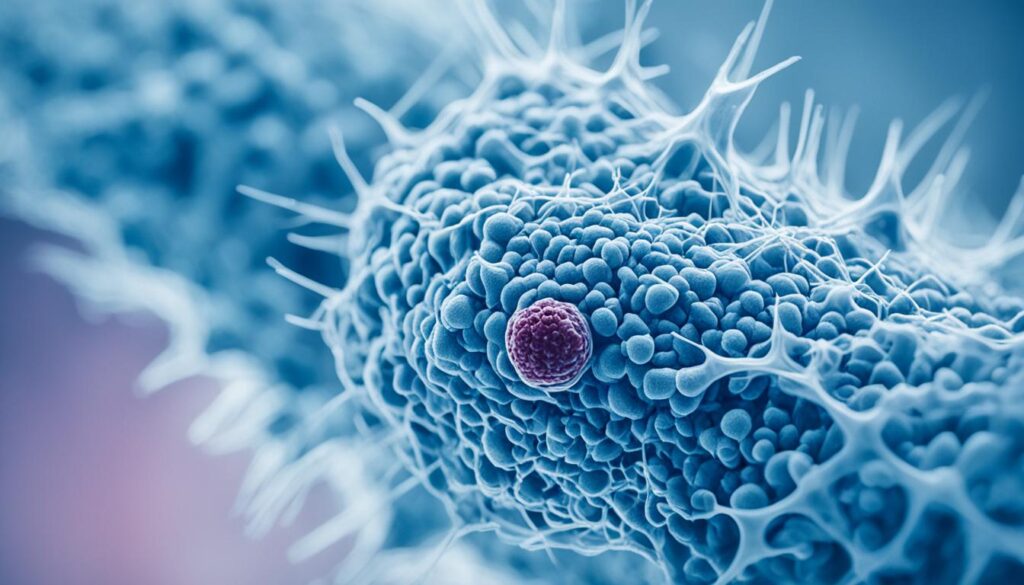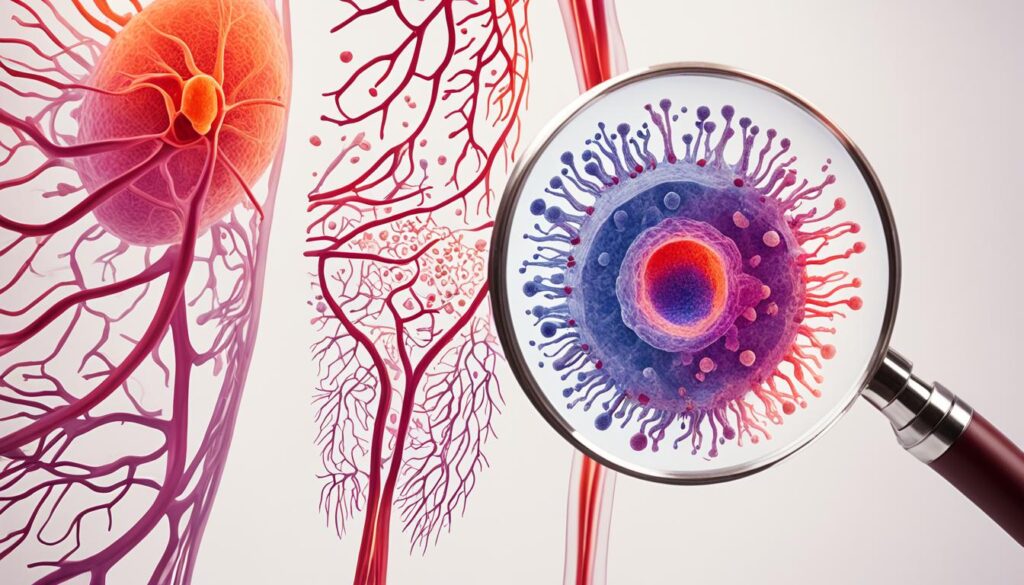Medically reviewed by Dr Chandril Chugh,
Renowned Neurologist and American Trained Specialist
Prostate cancer is a significant concern for men, with a 5-year survival rate of 64% in India alone. While it is commonly found in older males, there has been an alarming increase in cases among younger men. Unfortunately, many symptoms of prostate cancer go unnoticed or ignored, leading to more advanced stages of the disease.
Table of Contents
ToggleIt is crucial to be aware of the early signs of prostate cancer to ensure timely diagnosis and treatment. By recognizing these signs, you can take proactive steps to protect your health and well-being. In this article, we will explore the early signs, risk factors, diagnostic options, and preventive measures associated with prostate cancer.
Key Takeaways:
- Prostate cancer is a leading cancer among men, with a 5-year survival rate of 64% in India.
- Early detection of prostate cancer is crucial for successful treatment and improved outcomes.
- Recognizing the signs and symptoms of prostate cancer is essential for timely diagnosis.
- Regular screenings and adopting a healthy lifestyle can help reduce the risk of developing prostate cancer.
- Consulting a healthcare professional for personalized recommendations is important for individuals at risk.
What is Prostate Cancer?
Prostate cancer is a life-threatening condition that affects the prostate gland, a small walnut-shaped gland in males. The prostate gland produces seminal fluid that nourishes and transports sperm. The growth of prostate cancer often starts when cells in the prostate gland begin to grow out of control. The most common type of prostate cancer is adenocarcinoma, which develops in the glands that line the prostate. Prostate cancer can also occur in other parts of the body, such as the breast, stomach, lung, pancreas, and colorectal cancers.

Understanding the Prostate Gland
The prostate gland is an essential part of the male reproductive system, located just below the bladder and in front of the rectum. Its role is to produce and store the seminal fluid that combines with sperm during ejaculation. The fluid produced by the prostate gland helps nourish and protect the sperm as it travels through the reproductive system.
Prostate cancer is the second most common cancer in men worldwide. It is crucial to be well-informed about this condition to ensure early detection and timely treatment.
Prostate cancer can vary in severity, from slow-growing tumors that may not cause significant harm in a person’s lifetime to aggressive forms that require immediate treatment. Regular screenings and awareness of the early signs and symptoms are key in detecting prostate cancer at an early stage when treatment options are most effective.
Most Common Signs of Prostate Cancer to Note
Early stages of prostate cancer may present with a range of urinary symptoms that should be noted and monitored. These signs include:
- Trouble or difficulty in urination
- Burning or pain during urination
- Frequent urination at night
- Blood in the urine
- Blood in semen
In addition to urinary symptoms, other signs of prostate cancer may include loss of bladder control, erectile dysfunction, and painful ejaculation.
It is important to be aware that these symptoms may also be indicative of other benign illnesses. However, it is always recommended to take note of these signs and consult a healthcare professional for further evaluation to rule out any potential concerns related to prostate cancer.

Early Detection Saves Lives
Prostate cancer can often be successfully treated when detected in its early stages. By recognizing the signs and seeking prompt medical attention, you can significantly improve your chances of successful treatment and a positive outcome.
Early detection is key. Don’t ignore the signs. Your health is invaluable.
Stay informed, stay vigilant, and take control of your prostate health today.
What Happens When the Cancer Spreads Outside of the Prostate Gland
If prostate cancer is not diagnosed and treated early, it can spread outside of the prostate gland to other parts of the body, such as the bones and lymph nodes, causing more severe complications. When prostate cancer reaches an advanced stage and spreads beyond the prostate gland, it is known as advanced prostate cancer or metastatic prostate cancer.
Metastatic prostate cancer occurs when cancerous cells break away from the primary tumor in the prostate and travel through the bloodstream or lymphatic system to other organs or tissues, where they establish new tumors. The most common sites for prostate cancer metastasis are the bones, particularly the spine, hips, and pelvis, but it can also spread to the liver, lungs, and other distant areas of the body.
The sequel of metastatic prostate cancer has a detrimental impact on the overall well-being of the affected individual. It can lead to various symptoms and complications that significantly affect their quality of life. Some of the signs of advanced or metastatic prostate cancer include:
- Swelling in the legs or pelvic region
- Numbness or pain in the hips, legs, or feet
- Bone pain that persists or leads to fractures
If you experience any of these symptoms, it is crucial to seek medical attention from a healthcare professional. Early detection and appropriate management of advanced prostate cancer can help in alleviating symptoms, managing complications, and improving overall outcomes.

| Symptoms of Metastatic Prostate Cancer | Common Sites of Metastasis |
|---|---|
| Swelling in the legs or pelvic region | Bones, particularly the spine, hips, and pelvis |
| Numbness or pain in the hips, legs, or feet | Liver |
| Bone pain that persists or leads to fractures | Lungs |
Prostate Cancer Among Younger Men
Prostate cancer is commonly associated with older men, usually aged 65 and above. However, recent statistics indicate a concerning rise in the incidence of early onset prostate cancer among younger men, specifically those in the age group of 15 to 40. It is crucial for younger men to understand their risk factors and take proactive measures to protect their health.
Regular screenings play a vital role in the early detection of prostate cancer, regardless of age. By undergoing routine screenings, younger men can stay on top of their prostate health and identify any potential issues at the earliest stage. These screenings often include a physical examination and a prostate-specific antigen (PSA) blood test.
Recognizing the signs and symptoms of prostate cancer is equally important. While symptoms may vary, younger men should be aware of any unexplained urinary changes, such as increased frequency or difficulty in urination, blood in the urine or semen, and pain during urination or ejaculation. Any persistent symptoms or concerns should be promptly discussed with a healthcare professional.
“Early detection is key to improving outcomes in prostate cancer. It is important for younger men to take their prostate health
It is worth noting that prostate cancer diagnosed in younger men is often more advanced and may have a lower chance of survival compared to diagnoses in older men. This emphasizes the urgent need for awareness and vigilance among younger individuals.
Common Risk Factors for Younger Men
While age remains the primary risk factor for developing prostate cancer, there are other factors that can increase the likelihood of its occurrence in younger men. These include:
- A family history of prostate cancer or other cancers
- Genetic mutations in genes such as BRCA1 and BRCA2
- Exposure to certain environmental toxins or chemicals
- Unhealthy lifestyle habits, such as a poor diet and lack of exercise
By understanding these risk factors, younger men can make informed decisions about their lifestyle choices and actively work towards minimizing their risk of developing prostate cancer.
Your Role in Prostate Cancer Prevention
You have the power to take control of your prostate health and reduce the risk of prostate cancer. Here are some proactive steps you can take:
- Undergo regular prostate cancer screenings as recommended by your healthcare provider.
- Maintain a healthy lifestyle by eating a balanced diet rich in fruits, vegetables, and whole grains, exercising regularly, and avoiding tobacco and excessive alcohol consumption.
- Be mindful of any changes in your urinary function and promptly seek medical advice if you experience any unusual symptoms.
- Stay informed about your family history of cancer and discuss it with your healthcare provider.
Remember, early detection and intervention are key to successfully managing prostate cancer. By staying proactive and prioritizing your prostate health, you can help safeguard your well-being and ensure a healthier future ahead.

Prostate Cancer Among Indian Men
Prostate cancer is a significant health issue worldwide, ranking as the second most common cause of cancer and the sixth leading cause of cancer death among men. In India, prostate cancer is particularly prevalent, being the second leading site of cancer among males in major cities such as Delhi, Kolkatta, Pune, and Thiruvananthapuram. Additionally, it is among the top ten leading sites of cancer in the rest of the Indian population.
Prostate Cancer in Major Indian Cities
There is urgent need for awareness, early detection, and appropriate management of prostate cancer among Indian men. By promoting awareness campaigns, encouraging regular screenings, and providing access to quality healthcare, we can promote early diagnosis and improve outcomes for individuals affected by prostate cancer in India. It is crucial for Indian men to prioritize their health and seek medical attention promptly if any concerning symptoms arise.

In conclusion, prostate cancer is a significant health concern among Indian men, ranking high as one of the leading causes of cancer in major cities and the overall population. By raising awareness, promoting early detection, and ensuring appropriate management, we can make progress in combating prostate cancer and improving the overall well-being of Indian men.
Risk Factors for Prostate Cancer
While the exact cause of prostate cancer is unknown, several risk factors can indicate who is more likely to develop the disease. Understanding these risk factors and taking appropriate measures can help reduce the risk of prostate cancer.
Age
One of the primary risk factors for prostate cancer is age. The chances of developing prostate cancer increase significantly after the age of 50. The risk continues to rise with advancing age, making regular screenings and early detection crucial, especially for men above 50.
Family History
A family history of prostate cancer can also increase the risk. Men with a father, brother, or close relative diagnosed with prostate cancer are more likely to develop the disease themselves. Regular screenings and genetic counseling may be recommended for individuals with a family history of prostate cancer.
Obesity
Obesity is another risk factor for prostate cancer. Research suggests that excess body fat, especially around the waistline, can increase the risk of developing aggressive forms of prostate cancer. Maintaining a healthy weight through a balanced diet and regular exercise can help reduce the risk.
Lifestyle Factors
Unhealthy lifestyle habits, such as a poor diet and lack of exercise, can also contribute to the risk of developing prostate cancer. Consuming a diet rich in fruits, vegetables, and lean proteins, along with regular physical activity, plays a crucial role in reducing the risk of prostate cancer.
By understanding these risk factors and making necessary lifestyle changes, you can take proactive steps towards reducing your risk of developing prostate cancer. Regular screenings and consultations with healthcare professionals are essential in early detection and timely treatment.

Test Options for Prostate Cancer
To ensure early detection and timely treatment of prostate cancer, it is recommended that certain groups of individuals undergo regular screenings. These screenings are particularly important for men aged 50 or older with an average risk of prostate cancer, men aged 45 or older with a high risk (such as African-American men or those with a family history of prostate cancer), and men aged 40 or older with a higher risk (such as those with multiple first-degree relatives with prostate cancer).
There are several test options available for prostate cancer screening. These include:
- Digital Rectal Exam (DRE): This physical examination involves a healthcare professional inserting a gloved, lubricated finger into the rectum to feel the prostate gland. The purpose of this exam is to detect any abnormalities in the size, shape, or texture of the prostate.
- Prostate-Specific Antigen (PSA) Testing: PSA testing involves a blood test that measures the level of PSA, a protein produced by the prostate gland. Elevated levels of PSA may indicate the presence of prostate cancer.
- Ultrasound: Ultrasound uses sound waves to create images of the prostate gland. It can help determine the size and shape of the prostate and detect any abnormalities or tumors.
- Magnetic Resonance Imaging (MRI): MRI scans use powerful magnets and radio waves to create detailed images of the prostate gland. This imaging technique can help identify the location and extent of tumors.
- Prostate Biopsy: A prostate biopsy involves the collection of small tissue samples from the prostate gland for examination under a microscope. This procedure is typically performed if other tests, such as PSA testing or imaging, indicate the possibility of prostate cancer.
It’s crucial to consult a healthcare professional to determine which test or combination of tests is most appropriate for your individual situation. Regular screenings and early detection can greatly improve the chances of successful treatment and positive outcomes for prostate cancer.
Note: Regular prostate cancer screenings provide an opportunity to detect the disease in its early stages, when treatment options are most effective. Consult with your healthcare provider to determine the recommended screening schedule based on your risk factors and age.
Recurrent Prostate Cancer
Prostate cancer, like any other cancer, can recur after treatment. Recurrent prostate cancer refers to the return of cancer cells after a period of remission. It can occur locally, within the prostate gland, or spread to other parts of the body, known as metastatic prostate cancer. Monitoring for recurrent prostate cancer is vital to ensure timely intervention and management.
One early sign of recurrent prostate cancer is a rise in the PSA (prostate-specific antigen) level. PSA is a protein produced by the prostate gland, and an increase in its level may indicate the return of cancer cells. Regular testing of PSA levels is recommended for individuals who have completed treatment for prostate cancer.
In addition to elevated PSA levels, there are other symptoms that may indicate the recurrence of prostate cancer. These symptoms can vary depending on the extent and location of the recurrence. Common symptoms of recurrent prostate cancer include:
- Blood in urine
- Difficulty in urination
- Fatigue
- Lower backache
- Jaundice
If you have previously battled prostate cancer and are experiencing any of these symptoms, it is important to consult your healthcare provider immediately. They will evaluate your symptoms and conduct further tests to determine if the cancer has recurred. Timely diagnosis and appropriate management can improve outcomes and quality of life.

Risk of Recurrence
The risk of recurrent prostate cancer varies from person to person and depends on several factors. These factors include the stage and aggressiveness of the initial cancer, the effectiveness of the initial treatment, and individual health factors. Regular follow-up visits and screenings are essential to monitor for any signs of recurrence.
Management of Recurrent Prostate Cancer
The treatment options for recurrent prostate cancer will depend on several factors, including the location and extent of the recurrence, the individual’s overall health, and previous treatments received. Treatment may involve a combination of therapies such as radiation therapy, hormone therapy, chemotherapy, targeted therapy, and immunotherapy.
| Treatment Options for Recurrent Prostate Cancer | Description |
|---|---|
| Radiation Therapy | High-energy radiation is used to target and kill cancer cells. |
| Hormone Therapy | Medications are used to lower the level of hormones, such as testosterone, that promote the growth of prostate cancer cells. |
| Chemotherapy | Powerful drugs are used to kill cancer cells throughout the body. |
| Targeted Therapy | Drugs specifically target cancer cells, blocking their growth and division. |
| Immunotherapy | Treatment that uses the body’s immune system to fight cancer cells. |
Your healthcare provider will assess your specific situation and recommend the most appropriate treatment plan for recurrent prostate cancer. It is essential to have open and honest discussions with your healthcare team to make informed decisions about your care.
Self-Diagnosis of Prostate Cancer
While self-diagnosis of prostate cancer is not ideal, it is important to be aware of potential signs and symptoms by getting regular check-ups and staying informed about the disease. By understanding the risk factors and being proactive about monitoring your health, you can take steps towards early detection and prompt treatment.
One way to assess the risk of prostate cancer is through a PSA blood test, which measures the level of prostate-specific antigen in your blood. This test can be done at a healthcare facility and helps in identifying any abnormalities that may indicate the presence of prostate cancer.
In addition to the PSA blood test, a digital rectal exam (DRE) can also be performed by a healthcare professional. During this exam, the doctor will use a gloved finger to feel the prostate gland for any lumps, bumps, or other abnormalities. The DRE helps in detecting any physical changes in the prostate that may require further investigation.
If you experience any concerning symptoms such as urinary problems, blood in urine or semen, erectile dysfunction, or persistent pain in the pelvic area, it is crucial to consult a healthcare provider for a proper evaluation. They can conduct further tests, such as imaging scans or biopsies, to determine whether prostate cancer is present.

Remember, self-diagnosis should never replace professional medical advice. It is essential to consult a healthcare provider who can provide the necessary expertise and guidance for accurate diagnosis and appropriate treatment. Regular screenings, including the PSA blood test and digital rectal exam, play a vital role in detecting prostate cancer at an early stage when it is most treatable.
Reducing the Risk of Prostate Cancer
While there is no guaranteed way to prevent prostate cancer, making healthy lifestyle choices can help reduce the risk. By considering the following lifestyle choices, you can take proactive steps towards minimizing your chances of developing prostate cancer:
- Adopt a low-fat diet: Limit your intake of high-fat foods, opting for lean protein sources like poultry, fish, and legumes instead. Reduce consumption of red meat and processed meats.
- Increase fruit and vegetable intake: Incorporate a variety of colorful fruits and vegetables into your daily meals. These nutrient-rich foods contain antioxidants that may help protect against prostate cancer.
- Reduce dairy consumption: High intake of dairy products has been associated with increased prostate cancer risk. Consider substituting dairy products with alternative sources of calcium and protein, such as fortified plant-based milk and legumes.
- Maintain a healthy weight: Obesity is linked to an increased risk of prostate cancer. Aim to maintain a healthy weight through portion control, regular exercise, and a balanced diet.
- Be physically active: Engage in regular physical activity, such as brisk walking, jogging, or cycling. Regular exercise can help maintain a healthy weight and improve overall well-being.
In addition to lifestyle choices, regular screening and early detection are essential for minimizing the risk of prostate cancer. Consult with a healthcare provider to determine the appropriate screening schedule based on your individual risk factors and overall health.
Lifestyle Choices and Prostate Cancer Risk Reduction
| Lifestyle Choices | Risk Reduction Benefits |
|---|---|
| Low-fat diet | May help decrease the risk of prostate cancer development. |
| Fruit and vegetable intake | Rich in antioxidants that may provide protection against prostate cancer. |
| Reduced dairy consumption | Lowering intake of dairy products may reduce the risk of prostate cancer. |
| Maintaining a healthy weight | Obesity is associated with a higher risk of developing prostate cancer. |
| Regular physical activity | Engaging in regular exercise can reduce the risk of prostate cancer. |
Remember, while these lifestyle choices can contribute to a reduced risk of prostate cancer, it is essential to consult a healthcare provider for personalized recommendations based on your individual risk factors and overall health.
Conclusion
Prostate cancer is a significant health concern, particularly among men. It is crucial to recognize the early signs and symptoms of prostate cancer for timely detection and treatment. By undergoing regular screenings, such as PSA testing and digital rectal exams, you can increase the chances of early diagnosis.
Understanding the risk factors associated with prostate cancer and making necessary lifestyle changes can also help reduce the risk of developing the disease. By adopting a healthy lifestyle, including a low-fat diet, increased intake of fruits and vegetables, and maintaining a healthy weight, you can take proactive steps to minimize the likelihood of prostate cancer.
Consulting a healthcare professional is essential for personalized recommendations and to address any concerning symptoms or risk factors. Early detection and appropriate management are key in improving outcomes for individuals with prostate cancer. By staying informed about the disease, being proactive in your health, and seeking timely medical attention, you can take control of your prostate health and ensure a better future.
FAQ
What are the early signs of prostate cancer?
Early signs of prostate cancer may include trouble or difficulty in urination, burning or pain during urination, frequent urination at night, blood in the urine, blood in semen, loss of bladder control, erectile dysfunction, and painful ejaculation.
What is prostate cancer?
Prostate cancer is a life-threatening condition that affects the prostate gland, which produces seminal fluid that nourishes and transports sperm. The growth of prostate cancer occurs when cells in the prostate gland begin to grow out of control.
What are the most common signs of prostate cancer?
The most common signs of prostate cancer to note include urinary symptoms such as trouble or difficulty in urination, burning or pain during urination, frequent urination at night, blood in the urine, and blood in semen. Other signs may include loss of bladder control, erectile dysfunction, and painful ejaculation.
What happens when prostate cancer spreads outside of the prostate gland?
When prostate cancer spreads outside of the prostate gland, it can affect other parts of the body, such as the bones and lymph nodes, causing more severe complications. Signs of advanced or metastatic prostate cancer may include swelling in the legs or pelvic region, numbness or pain in the hips, legs or feet, and bone pain that persists or leads to fractures.
Is prostate cancer common among younger men?
While prostate cancer is commonly diagnosed in men aged 65 and above, there has been an increase in early onset prostate cancer in younger men, aged between 15 and 40. It is important for younger men to be aware of their risk factors, undergo regular screenings, and recognize the signs and symptoms of prostate cancer.
How common is prostate cancer among Indian men?
Prostate cancer is the second leading site of cancer among males in major Indian cities like Delhi, Kolkatta, Pune, and Thiruvananthapuram. It is also among the top ten leading sites of cancer in the rest of the Indian population.
What are the risk factors for prostate cancer?
Risk factors for prostate cancer include older age, a family history of cancer (especially prostate cancer), and obesity. Unhealthy lifestyle habits, such as a poor diet and lack of exercise, can also increase the risk of prostate cancer.
What are the test options for prostate cancer?
Prostate cancer screening options include digital rectal exams (DRE), prostate-specific antigen (PSA) testing, ultrasound, MRI, and prostate biopsy. These tests can aid in the early diagnosis of prostate cancer.
What are the symptoms of recurrent prostate cancer?
The first sign of recurrent prostate cancer may be a rise in the PSA level. Other symptoms of recurrent prostate cancer may include blood in urine, difficulty in urination, fatigue, lower backache, and jaundice.
Can prostate cancer be self-diagnosed?
While self-diagnosis of prostate cancer is not ideal, individuals can be aware of potential signs and symptoms by getting regular check-ups and staying informed about the disease. A PSA blood test and a digital rectal exam performed by a healthcare professional can help assess the risk of prostate cancer.
How can the risk of prostate cancer be reduced?
Making healthy lifestyle choices such as adopting a low-fat diet, increasing fruit and vegetable intake, reducing dairy consumption, maintaining a healthy weight, and being physically active can help reduce the risk of prostate cancer. Regular screening and early detection are also important for minimizing the risk.
